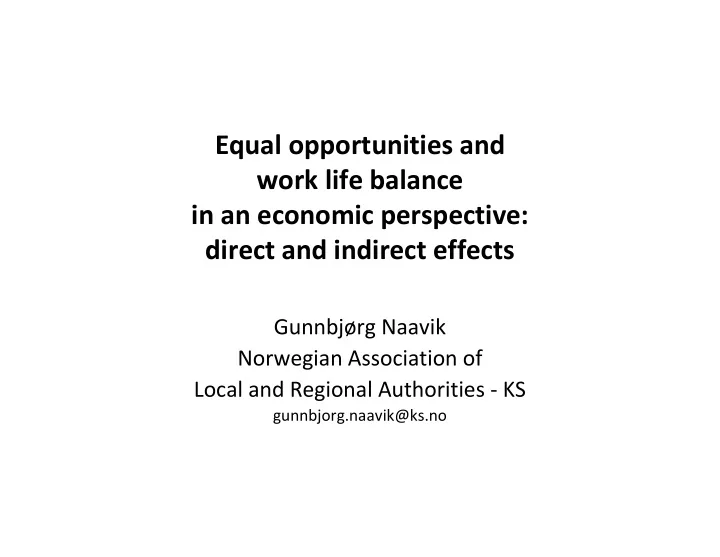

Equal opportunities and work life balance in an economic perspective: direct and indirect effects Gunnbjørg Naavik Norwegian Association of Local and Regional Authorities - KS gunnbjorg.naavik@ks.no
1. DIRECT ECONOMIC ASPECTS Equal opportunities and work life • balance can be studied and justified from many perspectives: human rights, democracy, sociology, quality This presentation is focusing on • the economic perspectives - direct and indirect economic effects
Point of departure - Equality between women and men, and work life balance, is a basis for demographic balance and labour participation, and a sustainable economy - A sustainable economy is a basis for equality between women and men - A crisis is a opportunity, a possibility for change
EU reduction of economic and social disparities 1996 Communication, “Incorporating • equal opportunities for women and men into all community policies and activities” 1997 Amsterdam Treaty, “Elimination • of inequalities and promotion of equality between women and men” 2006-2010 Roadmap for gender • equality 2006 The European Council European • pact for gender equality 2008 European Commission • communication on a better work life balance 2010 European commission women’s • Charter regarding Gender Equality strategy 2010-2015
EU Gender Equality Strategy and Action Plan 2010- 2015 September 2010 • Equal economic independence • Equal pay for equal work and ork of equal value • Equality in decision-making • Dignity, integrity and an end to gender-based violence • Gender equality in external actions • Horisontal issues (gender roles, legislation, governance and tools of gender equality)
Correlation between level of female employment and rate of fertility Source: Engelhardt, Henriette, and Alexia Prskawetz. 2004. “On the Changing Correlation Between Fertility and Female Employment Over Space and Time.” European Journal of Population 20: 35-62 (figure 2) Source: Wilkinson & Pickett, The Spirit Level (2009)
Effect on birth rate and demographic balance • WLB makes it easier for couples to have children • The sustainble birth rate is 2.1. The rates in Europe vary between 1.3 and 2.2. • Low birth rates means future economic problems; few adults to enter into the labour market.
Effects on employment • WLB implies new jobs, e.g. kindergartens and institutions, public sector management • New jobs implies increased employment rates and a more flexible labour market • There is a positive link between women’s employment rate and Gross National Product
Effects on taxes and consumption Taxes Consumption • 2 salaries families generally • 2 salaries families generally earn more than 1 salary consume more, - especially families -and pay more taxes if they have children • Taxes are the basis for all • Higher consumption is public services: schools, positive for private sector: hospitals, kindergartens, restaurants, shops, transport, institutions factories, services
2. INDIRECT ECONOMIC ASPECTS Utilizing all human resources • Better care for the elderly • Effects of unemployment • Effects of immigrant • unemployment Effects of day care • Effects on social capital • Effects on male role • Effects of postponed retirement • Effects on productivity • Effects on Innovation •
3. GENERAL EFFECTS OF ECONOMIC EQUALITY Main message Society benefits from greater economic equality – not only the poor – but the whole population. Examples: Life expectancy, literacy, infant mortality, homicides, imprisonment, mental illness, drug addiction, trust…………..
4.GRADUAL DEVELOPMENT Equal opportunities and WLB develop gradually – through • EU policies and legislation • National political processes and legislation • National social processes, and discussions, e.g. dissemination of ideas • National social dialogue between the parties • International projects, and exchange of learning
Recommend
More recommend